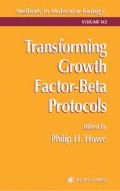Abstract
The mitogen-activated protein kinase (MAPK) superfamily includes three major subfamilies: extracellular signal-regulated kinase (Erks), c-Jun-N-terminal kinases (JNKs)/stress-activated protein kinases (SAPKs), and p38 kinases (1–3). Activation of MAPK requires the phosphorylation of both tyrosine (Y) and threonine (T) residues in a conserved motif: TEY for Erks, TPY for SAPKs, and TGY for p38 (1–3). These MAPKs, in turn, activate downstream substrates by phosphorylating a minimum consensus target sequence of Ser/Thr-Pro (1,2).
Access this chapter
Tax calculation will be finalised at checkout
Purchases are for personal use only
References
Treisman R. (1996) Regulation of transcription by MAP Kinasecascades. Curr. Opin. CellBiol. 8, 205–215.
Davis R.J. (1995) Transcriptional regulation by MAP kinases. Mol. Reprod. Dev. 42, 459–467.
Cano E. and Mahadevan L. C. (1995) Parallel signal processing among mammalian MAPKs. Trends Biochem. Sci. 20, 117–122.
Mulder K. M. and Morris S. L. (1992) Activation of p21ras by transforming growth factor β in epithelial cells. J. Biol. Chem. 267, 5029–5031.
Hartsough M. T. and Mulder K. M. (1995) Transforming growth factor β activation of p44mapk in proliferating cultures of epithelial cells. J. Biol. Chem. 270, 7117–7124.
Frey R. S. and Mulder K. M. (1997) TGFβ regulation of mitogen-activated protein kinases in human breast cancer cells. Cancer Lett. 117, 41–50
Frey R. S. and Mulder K. M. (1997) Involvement of extracellular signal-regulated kinase 2 and stress-activated protein kinase/Jun N-terminal kinase activation by transforming growth factor β in the negative growth control of breast cancer cells. Cancer Res. 57, 628–633.
Yue J., Frey R. S., and Mulder K. M. (1999) Cross-talk between the Smad1 and Ras/MEK signaling pathways for TGFβ, Oncogene 18, 2033–2037.
Hartsough M. T., Frey R., Zipfel P., Buard A., Cook S., McCormick F., and Mulder K. M. (1996). Altered transforming growth factor β signaling in epithelial cells when Ras activation is blocked. J. Biol. Chem. 271, 22,368–22,375.
Yue J., Buard A., and Mulder K. M. (1998). Blockade of TGFβ3 up-regulation of p27Kip1 and p21Cip1 by expression of RasN 17 in epithelial cells. Oncogene 17, 47–55.
Mucsi I., Skorecki K. L., and Goldberg H. J. (1996) Extracellular signal-regulated kinase and the small GTP-binding protein, Rac, contributing to the effects of transforming growth factor β1 on gene expression. J. Biol. Chem. 271, 16,567–16,572.
Atfi A., Djelloul S., Chastre E., Davis R. R., and Gespach C. (1997) Evidence for a role of Rho-like GTPase and stress-activated protein kinase/C-Jun N-terminal kinase (SAPK/JNK) in transforming growth factor beta-mediated signaling. J. Biol. Chem. 272, 1429–1432.
Wang W. F., Zhou G. S., Hu M. C.-T., Yao Z. B., and Tan T.-H. (1997) Activation of the hematopoietic progenitor kinase-1 (HPK1)-dependent, stress-activated c-Jun N-terminal kinase (JNK) pathway by transforming growth factor β (TGFβ)-activated kinase (TAK1), a kinase mediator of TGFβ signal transduction. J. Biol. Chem. 272, 22,772–22,775.
Hocevar B. A., Brown T. L., and Howe P. H. (1999) TGFβ induces fibronectin synthesis through a c-Jun N-terminal kinase-dependent, Smad4-independent pathway. EMBO J. 18, 1345–1356.
Mulder K. M., Segarini P. R., Morris S. L., Ziman J. M., and Choi H. G. (1993) Role of receptor complexes in resistance or sensitivity to growth inhibition by TGFβ in intestinal epithelial cell clones. J. Cell. Physiol. 154, 162–174.
Author information
Authors and Affiliations
Editor information
Editors and Affiliations
Rights and permissions
Copyright information
© 2000 Humana Press Inc.
About this protocol
Cite this protocol
Yue, J., Mulder, K.M. (2000). Activation of the Mitogen-Activated Protein Kinase Pathway by TGFβ. In: Howe, P.H. (eds) Transforming Growth Factor-Beta Protocols. Methods in Molecular Biology™, vol 142. Humana Press. https://doi.org/10.1385/1-59259-053-5:125
Download citation
DOI: https://doi.org/10.1385/1-59259-053-5:125
Publisher Name: Humana Press
Print ISBN: 978-0-89603-646-8
Online ISBN: 978-1-59259-053-7
eBook Packages: Springer Protocols

